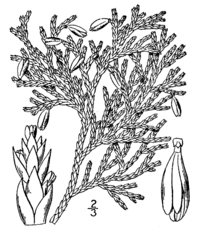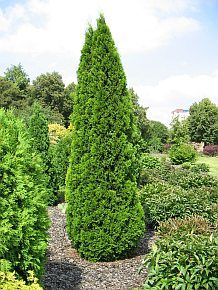Cupressus macrocarpa ‘Goldcrest’
syn. ‘Lemon yellow’
“Monterey Cypress”
CUPRESSACEAE
Evergreen Conifer Tree
Zone: 7 – 10
Native habitat : Coastal California (Monterey area)
Conditions
Soil: average
Moisture: well drained, moderate to regular
Light: full sun to full shade
Exposure: seaside
Plant size (h x w): to 33′ x 10′-15′
Other: tolerates stronger winds
 Aesthetic
Aesthetic
Shape/stem: upright, columnar, holds conical shape, flakey bark
Leaf: bright golden-yellow, ascending sprays, small, ,scale-like, colour persisting into winter
Flower:small, spherical female cones
Bloom: insignificant
Other: slow to grow; size can vary based on conditions
Treatment (how to…)
Plant: stake for the first year
Maintain: no pruning is required; don’t prune top till desired height, can prune to be hedge (late spring) otherwise prune out dead; rake out needles every so often
Propagate: cutting


Uses
Landscape: specimen, winter interest, evergreen tree, hedge, screen, windbreak, seaside, accent, architectural, hedge
Companion planting: look to colors of dark greens, full bodied greens, purples
Medicinal: unknown
Vulnerabilities
Pests and disease: none significant; may see cypress aphid
Deer resistant: yes; deer proof hedge too
Interest
Local info,: not native,
Pot size (to purchase): 2 g or bigger
Nature: small evergreen conifer tree
Identification (key features): distinct layered look to growth, foliage has a lemon scent to it
Comments: more stressed it is the more yellow it will be; very popular cultivar
Cultivars:‘Wilma Goldcrest’ – smaller at 15′ tall








 Aesthetic
Aesthetic











